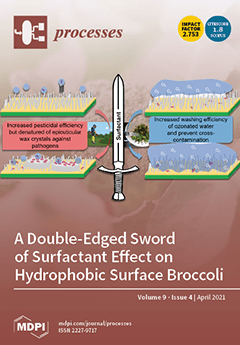Ostracoda species are indicators of their current and past environment (paleoenvironment). The study aims to evaluate the acute and chronic sensitivities of a freshwater ostracod species (
Eucypris sp.) to agricultural pesticides (a cypermethrin-based insecticide and a glyphosate herbicide-based formulation). Lethal concentrations (LC
50) of each pesticide for the species at 24 and 48 h were determined. The chronic exposure allowed assessing the effects of low concentrations of both pesticides; firstly, on the parthenogenetic reproduction of
Eucypris sp., and, secondly, on its population growth. Then, individuals of
Eucypris sp. were exposed to 0.536 ppb and 1.072 ppb of cypermethrin and 4.51 ppm and 9.03 ppm of glyphosate. These concentrations are respectively the 10%, and the 20% of the 48-h LC
50 (median lethal concentration) of both pesticides for the species. The estimated 24-h LC
50 of cypermethrin was 7.287 ppb. At 48-h, it was 5.361 ppb. For glyphosate, the 24-h LC
50 was 50.521 ppm, while at 48-h it was 45.149 ppm. After 10 days of exposure to low concentrations of cypermehrin, only 30% of females reproduced parthenogenetically with 10% and 20% of LC
50-48-h. For the control treatment, reproduction in 80% of females was observed.
Eucypris sp. population growth after 28 days of exposure to low concentrations of cypermethrin showed significant retardation. Regarding glyphosate chronic exposure, 60%, 50%, and 90% of individuals were able to reproduce at 10% of LC
50-48-h, 20% LC
50-48-h, and the control treatment, respectively. The population growth was also affected by the tested low concentrations of glyphosate. The study showed high sensitivity of
Eucypris sp. to cypermethrin compared to glyphosate. However, low concentrations of both pesticides affected the species at individual and population level.
Full article





